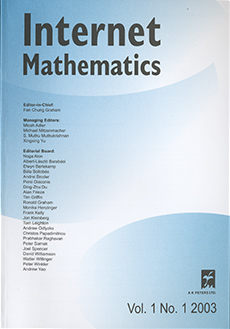Abstract
In the study of the spectra of power law graphs, there are basically two competing approaches. One is to prove analogues of Wigner's semicircle law while the other predicts that the eigenvalues follow a power law distributions. Although the semicircle law and the power law have nothing in common, we will show that both approaches are essentially correct if one considers the appropriate matrices. We will show that (under certain conditions) the eigenvalues of the (normalized) Laplacian of a random power law graph follow the semicircle law while the spectrum of the adjacency matrix of a power law graph obeys the power law. Our results are based on the analysis of random graphs with given expected degrees and their relations to several key invariants. Of interest are a number of (new) values for the exponent $\beta$ where phase transitions for eigenvalue distributions occur. The spectrum distributions have direct implications to numerous graph algorithms such as randomized algorithms that involve rapidly mixing Markov chains, for example.
Citation
Fan Chung. Linyuan Lu. Van Vu. "The Spectra of Random Graphs with Given Expected Degrees." Internet Math. 1 (3) 257 - 275, 2003/2004.
Information




